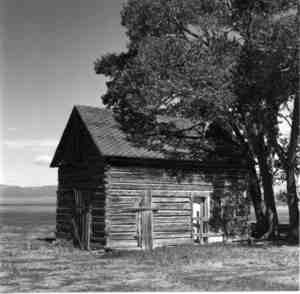Essay by Elaine Foster
Christo Project -March 2006 -Colorado Central Magazine
Residents of rural Frémont County are waging a fight against the big money people of the Christo Over the River Project. The European couple, Christo and Jeanne-Claude have secured fame and fortune by wrapping islands, bridges and buildings in plastic and fabric, and are now petitioning government agencies in Colorado for the necessary permits to stretch steel cables and fabric over the beautiful Arkansas River.
Local residents and outsiders who love the Arkansas River have joined forces to form the activist group ROAR, an acronym for Rags Over the Arkansas River. This group, now 1203 strong and growing by the day, are circulating petitions, contacting permitting agencies, and conducting rallies to voice their opposition to the Over the River project.
ROAR began as a trio of concerned women who met in Cathey Young’s kitchen and developed a plan that included a petition drive, a rally at the river, a letter writing campaign and intelligence gathering. They developed an e-mail address, trailblazers101@yahoo.com for distributing petition forms and information. A post office box was opened to collect the completed petitions, which are copied and mailed to all the permitting agencies.
Early meetings proved not to be well-attended and the group soon discovered their time and efforts were better spent communicating via the Internet. Their first real publicity success was a rally held in Cotopaxi at the river’s edge. Members strung ragged clothes on clotheslines across the river as a parody to Christo’s fabric.
Local newspaper reporters were invited and because of their coverage ROAR made headlines. After that event, the group held a meeting at the local senior center attracting T.V. coverage that aired in Denver and Colorado Springs. At every opportunity for publicity, ROAR members advertised their e-mail and post office addresses. Members were interviewed on numerous radio talk shows and began a lively letter writing campaign directed toward the government agencies from which Christo must obtain permits for his project.
The group’s spokesperson, Cathey Young, says the inherent problems of the project are many and the solutions are few or nonexistent. Christo’s Over the River plans propose a massive construction project starting 10 miles west of Canon City along Highway 50. Seven separate curtains of synthetic fabric, totaling seven miles, are to be stretched over steel cables connected to the banks of the river. The targeted areas are between Parkdale and Salida.
Christo anticipates that it could take two years to drill into the banks and install his cement caissons, which will supposedly support the steel cables. During this time, residents will experience highway closings to accommodate the construction equipment. Highway 50 is the principle thoroughfare for communities between Salida and Canon City; people use it to get to work, grocery stores, and clinics. The only alternative route is a 45-mile, two lane dirt road.
The Bureau of Land Management anticipates 250,000 people may flock to Frémont County during a two-week period during the summer to view Christo’s fabric. “The current population of this county is less than 50,000,” says Young. “We simply cannot accommodate five times our population in this rural area.”
People who hear about the project for the first time ask, “What’s the point to all this?” Christo answers, “Art.” ROAR members answer, “Money.” An Internet search will reveal that Christo sinks millions into these projects and reaps more millions in return.
Many of the opponents to the Christo Project are artists and art lovers. ROAR has painters and carvers among its members, but none of them believe that art should be forced upon people, allowed to inconvenience the population for years, threaten wildlife, or permanently damage a river.
Highway 50 winds through a narrow canyon, and in many places there’s a rock wall on one side with the river on the other. It’s hard to imagine how the anticipated crowds will get through in the event of an accident.
Another major concern is the disruption to the wildlife that live near Bighorn Sheep Canyon along the Arkansas River. Bighorn sheep, deer, elk, mountain lions, bald and golden eagles, peregrine falcons and a variety of fish are just some of the species that live there, reports Cathey Young. The stress and danger this project will cause our wildlife is unacceptable. The stress tests conducted in earlier years by implanting heart monitors in the bighorn sheep have not shown favorable results. Stress causes the herd to be more susceptible to disease, and though they are able to tolerate the current levels of tourism, a huge influx may cause the herd to leave the area.
Fire danger is another real concern. The fear is that thousands of tourists will crowd onto the state and federal lands that border the river during the height of the fire-danger season. There’s simply no way to prevent a wildfire with tourists discarding cigarettes, starting campfires, and driving their vehicles over tinder-dry grass, says Young. Local residents know that it took only one out-of-towner leaving a charcoal grill unattended to start the 2002 Iron Mountain Firestorm in this area, and it destroyed over 80 homes and killed pets, livestock and wildlife.
No viable solutions have been proposed for medical emergencies that will occur in the canyon during this project. Highway 50, a two-lane road, already has its share of accidents during the normal course of the year. During the height of the Christo exhibition, both lanes will be bumper to bumper with no means for emergency vehicles to quickly reach the scene. To compound the problem, the nearest hospitals are at each end of the canyon, 60 miles apart.
During a normal summer, both hospitals treat their share of tourists with altitude sickness and breathing problems since this region averages 7,000 feet above sea level. How can they be expected to accommodate the additional number of people who may suffer from sunstroke and heat exhaustion after being stuck on Highway 50 during peak summer temperatures? And with tens of thousands of extra tourists in the canyon, there’s bound to be an increased number of accidents, illnesses and injuries to deal with, too.
Proponents of the project constantly misrepresent the entire event as lasting only two weeks. However, Christo’s own web site states that the construction and dismantling will take at least three years.
Christo’s track record is less than satisfactory. The risk assessments of two past commercial ventures proved to be inadequate. The umbrella project resulted in two fatalities, and the Rifle, Colorado curtain blew down twice, both times within 28 hours.
ROAR is currently imploring prominent community leaders and business owners to publicly declare their opposition to Christo’s scheme.
Western Frémont County residents do not want to be Christo’s next victims. Their battle cry is “Let’s put Frémont County on the map by being the little county who said No to the rich and powerful in order to save the Arkansas River and the wildlife that lives there.”
Elaine Foster is an artist and one of the founders of ROAR. She writes a bi-monthly newsletter, The Fireside Chat, about the local fire district and her husband is a volunteer firefighter with a nearby fire department. They also volunteer as the grant-writers for the area ambulance service. To get more information or petitions, contact ROAR at trailblazers101@yahoo.com or write to P.O. Box 786, Canon City, CO 81215.


